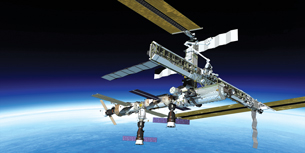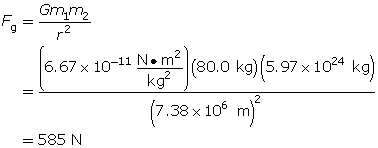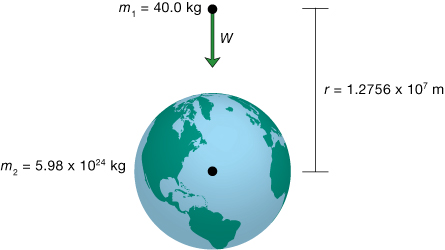Module 4—Gravitational Force
 Lesson 2 Lab: Newton’s Law of Universal Gravitation
Lesson 2 Lab: Newton’s Law of Universal Gravitation

© Stephen Strathdee/shutterstock
The International Space Station orbits Earth.
The International Space Station is an example of an object orbiting Earth. Earth’s gravitational force helps keep the ISS in orbit.
The Weight and Orbits simulation used in this lab simulates the trajectory and gravitational force acting on a particle in Earth's gravitational field by varying its initial position and velocity.
Problem
Why does an object’s weight change if it moves away from Earth's surface?
Open the simulation; then continue with the Procedure section. You may be required to login with a username and a password. Contact your teacher for this information. You can learn more about the simulation and how to use it by reading the Show Me found at the top of the simulation screen.
Procedure
Once you have completed the lab, there is a Self-Check question. There are also lab questions to answer that you will submit to your teacher as part of your Module 4: Lesson 2 Assignment.
“Reset” (![]() ) the simulation, and set the distance scale to 100 pix = 10 000 km. Move the satellite to the North Pole by setting the x and y positions to 0 km and pressing “Enter.” Display the “Data” box (
) the simulation, and set the distance scale to 100 pix = 10 000 km. Move the satellite to the North Pole by setting the x and y positions to 0 km and pressing “Enter.” Display the “Data” box (![]() ).
).
Observation
 Self-Check
Self-Check
SC 1. Record the weight, W, of the satellite shown at the bottom of the data box. What is the weight of the satellite at Earth's surface?
 Self-Check Answers
Self-Check Answers
SC 1. The weight of the satellite at Earth's surface is 393.2 N.
 Module 4: Lesson 2 Assignment
Module 4: Lesson 2 Assignment
Remember to submit the answers to LAB 1 and LAB 2 to your teacher as part of your Module 4: Lesson 2 Assignment.
Analysis
LAB 1. Using W = mg, determine if the satellite’s weight is consistent with the satellite's mass given as 40.0 kg and the acceleration due to gravity at the surface of the Earth (9.81 m/s2).
Note: The acceleration due to gravity on Earth’s surface is denoted g and is approximately constant at 9.81 m/s2. In the simulation data box, the acceleration is denoted a and is not constant, as you will see, when you move the satellite away from the surface of Earth. Thus, the symbol g denotes a constant that applies at Earth’s surface, and the symbol a denotes a variable (less than 9.81 m/s2) for the acceleration due to gravity at any arbitrary point away from Earth.
LAB 2. What is the satellite's weight at a point one Earth radius above Earth’s surface? On the simulation, position the satellite at x = 0 km and y = 6378 km. Enter these values in the position data entry fields, and then press “Enter.” To view the satellite’s new position, zoom out using the scale selections. Again, the weight is displayed at the bottom of the data box.
- What is the weight of the satellite at one Earth radius from the surface?
- If the satellite’s weight changed but its mass remained constant, what variable has changed according to W = ma?
 Read
Read
Could the weight have been figured out without the simulation using Newton’s law of universal gravitation? The formula looks more complex than many you have encountered, but with a calculator it is not too bad. Read from the middle of page 206 to the end of “Example 4.1” on page 207 of the physics textbook to see an example of how the law is used in calculations. Then you get a couple of chances to try it yourself.
 Self-Check
Self-Check
SC 2. What will be the weight of an 80.0-kg astronaut at a height of 1000 km above the surface of Earth? Use the data for the mass and radius of Earth from “Example 4.1” of the textbook.
 Self-Check Answers
Self-Check Answers
SC 2.
Given
ma = 80.0 kg
mE = 5.97 × 1024 kg
rE = 6.38 × 106 m
h = 1000 km = 1.000 × 106 m
Required
the weight of the astronaut (![]() )
)
Analysis and Solution
The distance of the astronaut from the centre of Earth will be (6.38 × 106 m + 1.000 × 106 m) or 7.38 × 106 m. The weight of the astronaut will be the force of gravity on the astronaut, which can be calculated using Newton’s law of universal gravitation.

Paraphrase
The weight of the astronaut will be 585 N.
 Module 4: Lesson 2 Assignment
Module 4: Lesson 2 Assignment
Remember to submit the answer to LAB 3 to your teacher as part of your Module 4: Lesson 2 Assignment.
LAB 3. Away from the surface of Earth, W = mg is no longer valid. You would need to use W = ma, assuming that you knew what the acceleration was at the satellite’s position. (Remember that g is a constant 9.81 m/s2 and is only valid at Earth’s surface.) Newton's law of universal gravitation is most useful away from the surface of Earth. Use this equation to determine if the satellite’s weight in LAB 2 is consistent with the satellite's mass (40.0 kg) and the distance between the centre of Earth and the satellite. See the accompanying illustration.
